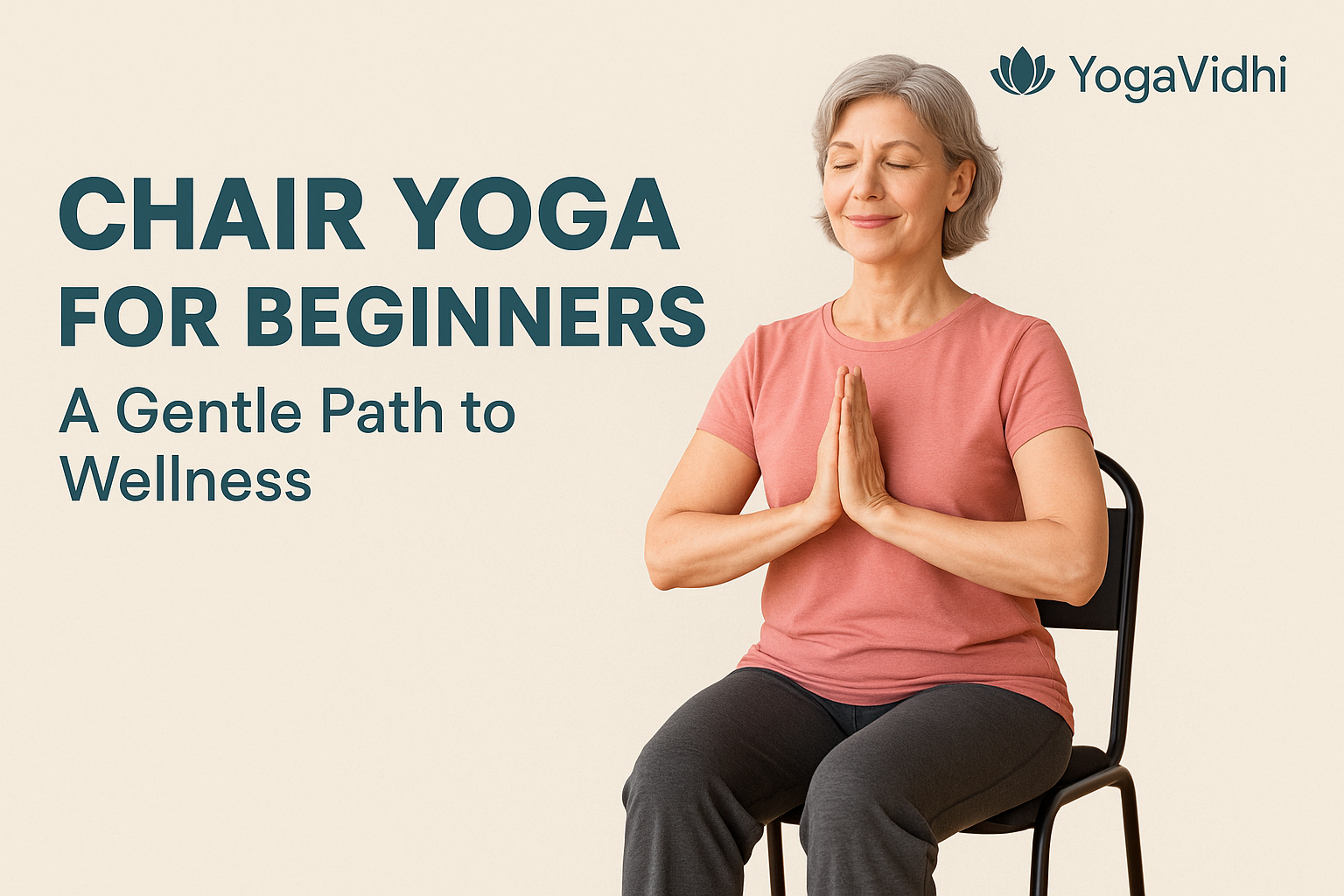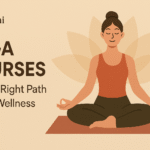When most people think of yoga, they imagine twisting poses on a mat, flexible bodies, or balancing on one leg. But what if we told you that you don’t need to be flexible, athletic, or even get down on the floor to experience the life-changing benefits of yoga? Welcome to the world of chair yoga for beginners—a gentle, accessible, and deeply healing practice that meets you exactly where you are.
Whether you’re easing into movement after a period of inactivity, dealing with joint pain, recovering from an injury, or simply seeking a more approachable way to start yoga, chair yoga is your perfect entry point.
Chair yoga for beginners provides a gentle approach to enhancing flexibility, strength, and balance within a safe and supported setting. It’s perfect for beginners, older adults, or individuals with limited mobility, as it adapts traditional yoga poses by incorporating a chair for added support.
Table of Contents
What is Chair Yoga?
Chair yoga is a modified version of traditional yoga where poses are performed while seated or using a chair for support. It offers all the benefits of yoga—like increased flexibility, strength, and relaxation—but without the need to get on the floor. This makes it ideal for beginners, older adults, office workers, and anyone with mobility challenges.
Originating from the desire to make yoga more inclusive, chair yoga has evolved into a respected practice in its own right. It’s now offered in senior centers, corporate offices, hospitals, and homes around the world.
Benefits of Chair Yoga for Beginners
Practicing chair yoga for beginners is about more than just moving your body—it’s about cultivating mindfulness, improving your health, and feeling good in your own skin. Here are some of the powerful benefits:
Improved Flexibility
Chair yoga gently stretches your muscles, increasing your range of motion over time without strain or discomfort.
Builds Strength
Using your body weight in poses like Seated Warrior helps tone your muscles and improve balance—even while sitting.
Reduces Stress and Anxiety
Like other forms of yoga, chair yoga incorporates mindful breathing and slow, intentional movement. This calms your nervous system and helps relieve anxiety.
Enhances Circulation
Gentle movement improves blood flow and helps with joint lubrication, especially important for those with arthritis or sedentary lifestyles.
Boosts Mental Clarity
Regular chair yoga practice supports cognitive function, improves focus, and helps you feel more grounded and centered.
Is Chair Yoga Right for You?
Chair yoga is especially suited for:
- Beginners who feel intimidated by traditional yoga
- Seniors looking for a safe and gentle fitness option
- Office workers seeking to stretch during work hours
- People recovering from injury or surgery
- Individuals with chronic conditions like arthritis or balance issues
If you’re unsure, always consult your doctor before starting a new movement practice—especially if you have any underlying medical conditions. But in general, chair yoga for beginners is one of the safest, most accessible ways to bring movement back into your life.
How to Get Started with Chair Yoga
The beauty of chair yoga for beginners is that it’s incredibly easy to start. Here’s what you’ll need:
The Right Chair
Choose a sturdy chair without wheels. Ideally, it should have no armrests and a straight back. This allows freedom of movement and better posture.
Comfortable Clothing
Wear loose-fitting or stretchy clothes that let you move freely.
Optional Props
Yoga straps, resistance bands, cushions, or light hand weights can enhance your practice but aren’t necessary for beginners.
Safety First
- Sit up tall with feet flat on the floor
- Engage your core and breathe deeply
- Avoid jerky movements and never force a stretch
Read More: Yoga for Anxiety: How to Find Calm, Clarity, and Confidence Through Movement
Read More: Chair Yoga for Seniors: A Gentle Path to Flexibility, Strength, and Peace
| Chair Yoga Pose | Benefits | Difficulty Level |
| Seated Mountain Pose | Improves posture and body awareness; activates core muscles | Easy |
| Seated Cat-Cow Stretch | Enhances spinal flexibility; relieves back tension | Easy |
| Seated Forward Bend | Stretches back and hamstrings; calms the mind | Easy |
| Seated Spinal Twist | Improves spinal mobility; aids digestion | Easy to Moderate |
| Chair Pigeon Pose | Opens hips; reduces lower back and hip tightness | Moderate |
| Seated Warrior Pose | Builds lower body strength; improves balance and focus | Moderate |
| Neck & Shoulder Rolls | Relieves tension; promotes relaxation | Very Easy |
| Seated Savasana | Encourages deep relaxation and stress relief | Very Easy |
Simple Poses of Chair Yoga for Beginners
Here are some foundational chair yoga poses that are perfect for newcomers. Practice these slowly and focus on your breath.
1. Seated Mountain Pose (Tadasana)
Sit tall with feet flat, spine long, and hands on thighs. Inhale deeply, lengthening your posture. Exhale slowly.
Benefits: Promotes posture awareness and core strength.
2. Seated Cat-Cow Stretch
Place hands on knees. Inhale to arch your back (cow), lift the chest. Exhale to round the spine (cat), tucking the chin.
Benefits: Eases back tension, improves spinal flexibility.
3. Seated Forward Bend
Exhale and hinge forward from the hips, letting your arms dangle toward the floor or rest on your legs.
Benefits: Stretches the back and hamstrings, encourages relaxation.
4. Seated Spinal Twist
Place your right hand on the back of the chair and left hand on your thigh. Inhale to sit tall, exhale to gently twist. Repeat on the other side.
Benefits: Improves spinal mobility and aids digestion.
5. Chair Pigeon Pose
Cross one ankle over the opposite knee. Sit tall and gently press the top knee downward.
Benefits: Opens hips and reduces lower back tightness.
6. Seated Warrior Pose
Step one foot back while keeping the other foot forward and bent at a 90° angle. Raise your arms overhead or to shoulder height.
Benefits: Builds strength, stability, and confidence.
7. Neck & Shoulder Rolls
Gently roll your shoulders forward and backward. Slowly tilt your head side to side.
Benefits: Releases tension in the neck and upper body.
8. Seated Savasana (Relaxation)
Close your eyes, rest your hands on your lap, and take slow, deep breaths.
Benefits: Calms the mind and integrates your practice.
Sample 10-Minute Chair Yoga Routine
Here’s a beginner-friendly routine to help you ease into the habit:
Warm-Up (2 minutes):
- Seated Mountain Pose
- Neck & Shoulder Rolls
Main Sequence (6 minutes):
- Cat-Cow Stretch
- Seated Spinal Twist
- Seated Forward Bend
- Chair Pigeon Pose
- Seated Warrior (Both Sides)
Cool Down (2 minutes):
- Deep Breathing
- Seated Savasana
Start with this routine 3–4 times a week, then gradually increase frequency.
Tips for Success in Chair Yoga
Starting something new can feel overwhelming, but these tips will help you stay consistent and confident:
- Listen to Your Body – Don’t push through pain. Modify poses when needed.
- Be Consistent – Short daily sessions are more effective than occasional long ones.
- Focus on Breath – Synchronizing breath with movement enhances benefits.
- Stay Present – Let go of distractions. Be mindful of how your body feels.
- Set Simple Goals – Track progress to stay motivated.

Common Mistakes to Avoid
Even though chair yoga is beginner-friendly, here are some mistakes to steer clear of:
- Using a wobbly or rolling chair
- Skipping warm-up or breathwork
- Rushing through poses
- Forgetting to breathe deeply
- Comparing yourself to others
Conclusion: It’s Never Too Late to Start Yoga
You don’t need to be young, bendy, or fit to start your yoga journey. With chair yoga for beginners, all you need is a chair, a little time, and the willingness to try something new.
This gentle form of chair yoga for beginners can transform how you move, feel, and live—one breath and one pose at a time. So, pull up a chair and begin your journey to flexibility, peace, and vitality today.
Ready to get started? Your chair is waiting.
FAQs About Chair Yoga for Beginners:
Q. Can I do chair yoga every day?
Ans: Absolutely! Daily practice can improve flexibility, reduce stress, and enhance well-being over time. Just listen to your body and take rest when needed.
Q. Is chair yoga really effective?
Ans: Yes! Numerous studies and testimonials show that chair yoga improves strength, reduces pain, and enhances mental clarity—especially for beginners and seniors.
Q. Do I need any special equipment for chair yoga?
Ans: Yes, chair yoga can be very effective for relieving back pain and joint stiffness. Gentle stretches and movements increase circulation, improve posture, and ease muscular tension—making it an excellent practice for people with chronic pain or arthritis.
Q. How long should a beginner practice chair yoga each day?
Ans: Start with 10–15 minutes per session, 3 to 4 times a week. As you get comfortable, you can gradually increase the duration. Consistency is more important than intensity when beginning chair yoga.
Q. Does chair yoga really work for beginners?
Ans: People often say that “exercise is the best medicine,” and chair yoga is a perfect example of that. It’s a simple, accessible form of exercise that anyone can do. As you begin practicing chair yoga, you’ll likely notice a calming sense of ease and relaxation spreading through your body.
Q. Does chair yoga work for belly fat?
Ans: Although no exercise can target fat loss in a specific area, chair yoga supports overall fat reduction, including belly fat. It works by boosting metabolism and reducing stress—both common contributors to weight gain.
Declaration Note:
We use third-party videos and images on https://yogavidhi.com/ for educational and illustrative purposes. All rights belong to their respective owners. No copyright infringement is intended.



